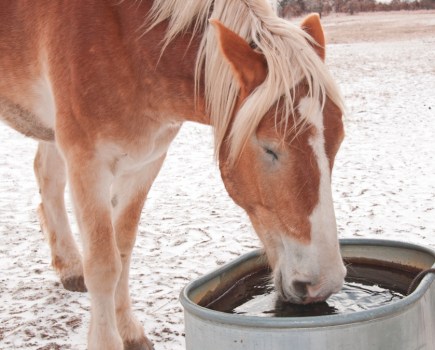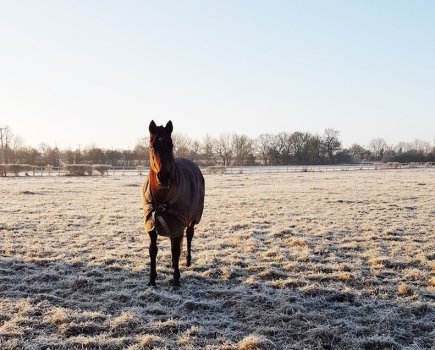A horse’s stable environment plays an integral role in their general health, wellbeing and, by association, their athletic performance. But while most people are aware of the implications of stable dust on a horse’s respiratory tract, stable ammonia — a noxious gas — is frequently forgotten when taking care of a horse on a day to day basis.
Urea, a protein breakdown product, is eliminated from the body in urine. Ammonia gas is formed when bacteria which produce an enzyme called urease break down the urea in this urine. Bacterial numbers subsequently increase and the process perpetuates. Ammonia-producing bacteria live on the stable floor as well as underneath and in between rubber matting. Considering that horses can produce 15-30ml of urine per kg of bodyweight per day (for a 500kg horse, that’s 7.5-15 litres of urine per day), bacteria are rarely without a surface material.
What is ammonia?
Ammonia (NH3) is a caustic gas. Caustic means strongly alkaline (as opposed to strongly acidic). Ammonia is well recognised as sufficiently alkaline to be a strong irritant, even in small doses and at relatively low concentrations. Exposure to ammonia irritates vulnerable tissues, such as the skin, eyes, nasal passages, sinuses, the respiratory tree and the lungs. It can have an unsavoury affect on both your horse’s health and also your own.
Identifying ammonia
In a non-equine environment, humans can rapidly detect the smell of ammonia at relatively low concentrations. When sniffed, ammonia fumes cause a startle-type reflex that is our instinctive response to noxious gases on receptors attached to our eyes and respiratory passages. This reaction triggers an alarm from a region of the brain called the amygdala, which protects us by instantly making us pull away from things our brain registers as potentially harmful.
However, in the stable environment we subconsciously associate the smell of ammonia with our horse, so we’re less reactive to it. Coupled with the length of time we spend with our horse, our nasal receptors’ response to the smell of ammonia subsides over time so that we become less aware of ammonia exposure and inhalation.
Ammonia and human health
This has obvious implications for our own health. Humans can smell ammonia at concentrations of 30 parts per million (ppm). Concentrations of 50ppm result in nasal and eye irritation, while at 1,000ppm there may be severe lung dysfunction. Concentrations of 1,500ppm can result in death.
Work carried out by Dr Karen Hayes revealed that in a well-managed stable environment, concentrations of ammonia ranged from 80-450ppm within 12in from the stable floor. Concentrations were 10-50ppm 5ft from the floor, and 0-15ppm in the aisles between stables. Ammonia levels will undoubtedly be higher in less well-managed stables and those whose stables are not cleaned out daily.
Ammonia and horse health
Concentrations of ammonia in the stable environment can inevitably be irritating for horses but, fortunately, lethal concentrations are rarely reached. However, respiratory tract irritation may exacerbate underlying health conditions such as asthma (formerly known as COPD or RAO) with obvious implications on health and athletic performance.
Vets regularly see allergic airway disease, with some cases being quite challenging to control, and while the primary cause of these is certainly not ammonia, ammonia can inevitably exacerbate the clinical signs noted. Ammonia can also attract flies, whose presence will irritate horses, as well as causing insect bite hypersensitivity in some individuals.
Ammonia exposure
The effects of ammonia exposure in people can range from short-lived reversible discomfort to serious health effects that are chronic, irreversible and sometimes even life-threatening. Exposure to high concentrations of ammonia in the air causes immediate burning of the eyes, nose, throat and respiratory tract, and it can result in blindness and lung damage as well as death. Inhalation of lower concentrations of ammonia can cause coughing as well as nose and throat irritation.
How to control ammonia in the stable
While we can’t reduce the amount of urine a normal horse produces, management is based on stable hygiene and cleanliness:
- Urine-soaked bedding, as well as soiled bedding, should be completely removed twice daily. Ideally, owners should avoid deep litter beds, too.
- Stables should be fully cleaned out, power washed and disinfected regularly. The stable floor should also be carefully considered.
- For many owners, the type of flooring may be out of their control if they keep their horse at a livery yard. However, if you have the scope to design your own stable floor, select a completely impervious material to ensure that the edges are sealed, meaning the urine won’t leak through to the surface below.
- A lack of permeability also gives the bedding used the best opportunity to absorb as much urine as possible. Such flooring will also be easy to clean.
Rubber matting and ventilation
Unfortunately, though, the majority of us aren’t in a position to select our own stable flooring and so we can only do our best with the resources available. If you use rubber matting, for example, try to ensure that there aren’t large gaps between the mats which will allow both bedding and urine to seep in between and under the matting, perpetuating ammonia production.
Consult the provider of the matting to ensure the best fit for your stable. Regular cleaning of mats (including in between and the underside) should also be a part of your regime.
A lot of stables aren’t very well ventilated. Improving ventilation has many health benefits, including reducing stable ammonia levels, but as the building’s structure will probably need significant alteration this may not be possible. By being better informed about this noxious gas and the negative impacts it can have on human and horse health, we can make better decisions about how we manage our horses and hopefully reduce ammonia levels in the stable.
Profuse nasal discharge
Jack, a 12-year-old cob, initially presented to me at Oakhill Veterinary Centre in March. He had had a cough for four days and a pus-like nasal discharge for the last 24 hours. A number of other horses on Jack’s stable block were also affected. He had no previous history of respiratory tract issues.
When I examined him, I found Jack to have a normal breathing rate and temperature. He coughed multiple times during his exam and the nasal discharge was profuse. Based on his history and the clinical signs, I diagnosed a virus with a secondary bacterial infection.
I sent a sample of the nasal discharge to the lab for evaluation to decide on the best antibiotics to use, and Jack was started on a course of broad-spectrum anti microbials and anti-inflammatories. After three days his owner reported that the nasal discharge had stopped, although Jack’s cough was still ongoing.
Clinical signs got worse
However, five days later the nasal discharge returned. Respiratory tract endoscopy (camera visualisation) showed mucus covering the inside of Jack’s nasa passages, pharynx and trachea. His respiratory tract was also inflamed. I took a sample from his trachea and lower airway, and the results indicated moderate lower airway inflammation.
This time no bacteria were isolated so a working diagnosis of asthma was made. Oral medication was prescribed: clenbuterol to relieve airway spasm and to open Jack’s airways, plus steroids to reduce airway inflammation.
Jack’s clinical signs were worse when he was stabled, so his owner was advised to give him as much turnout as possible, to groom him outdoors, and to lay down new bedding when he was outside his stable, again to minimise stable dust inhalation. Jack’s owner elected to bed him on dust-extracted shavings and to give him soaked hay. Jack showed a 50% improvement with his nasal discharge; however, his cough was ongoing and so the veterinary team decided to switch to nebulised medications.
Ammonia was an exacerbating factor
Jack showed further improvement with these, but his clinical signs were still not resolved. At this point, we re-evaluated his stable environment and advised his owner to vacuum the stable thoroughly to remove all cobwebs, and also to remove his relatively deep bed in its entirety.
The stable was then cleaned, power-washed and disinfected — including in between and beneath the rubber matting. There were significant gaps between the rubber mats which were allowing urine-soaked bedding to penetrate between them and subsequently beneath the mats. This meant that ammonia-producing bacteria were able to proliferate, with the resulting ammonia potentially exacerbating the clinical signs of asthma.
Given these concerns, Jack’s owner made the decision to buy new, better-fitting rubber mats for his stable, and also to keep him on a smaller bed to make thorough daily cleaning much easier. Jack’s symptoms resolved and we were able to taper him off his nebulised medications. Once the ammonia levels in his stable were addressed, Jack showed a huge improvement in his clinical signs, indicating that ammonia was likely an exacerbating factor for his asthma.








